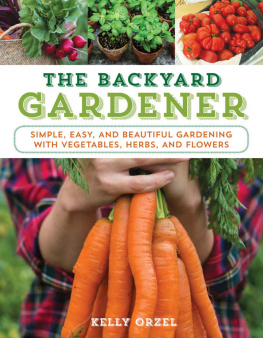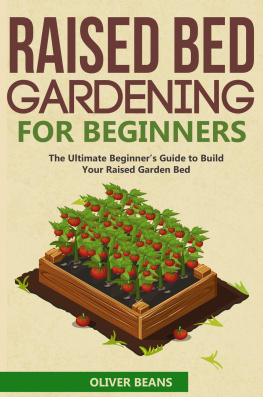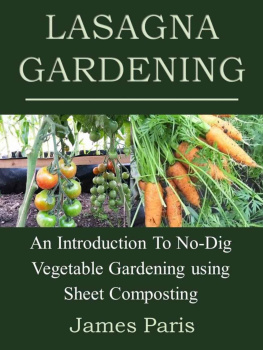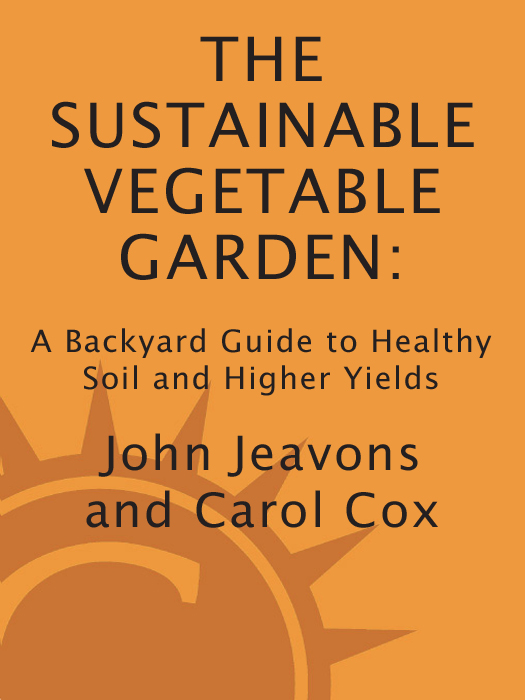Copyright 1999 by Ecology Action of the Midpeninsula
All rights reserved. Published in the United States by Ten Speed Press, an imprint of the Crown Publishing Group, a division of Random House, Inc., New York.
www.crownpublishing.com
www.tenspeed.com
Ten Speed Press and the Ten Speed Press colophon are registered trademarks of Random House, Inc.
Ecology Action
5798 Ridgewood Road
Willits, CA 95490-9730
(707) 459-0150
Much of the data and other information in this book has been drawn from How to Grow More Vegetables, fifth ed., by John Jeavons, Ten Speed Press, 1995.
Library of Congress Cataloging-in-Publication Data
Jeavons, John.
The sustainable vegtetable garden: a backyard guide to healthy soil and higher yields/John Jeavons and Carol Cox; illustrations by Sue Ellen Parkinson.
p. cm.
Rev. ed. of: Lazy-bed gardening. c1993.
1. Vegetable gardening. 2. Biointensive gardening. I. Cox, Carol. II. Jeavons, John. Lazy-bed gardening. III. Title.
SB324.3.J47 1999
635dc21
98-49296
eISBN: 978-0-307-79049-1
v3.1
To the gardeners of the Earth,
who are breathing life back into the soil
Contents

Acknowledgments
Special thanks to
the people at Ten Speed PressPhil Wood, publisher; Toni Goode, for cover design; Laura Lind, of Laura Lind Design, for book design; Wade Fox, for copy-editing; Jean Mann for proofreading and indexing; and Jason Rath, project editor, for his patience and persistence in asking incisive questions. Everyone assisted in so many ways so this book could be published at this time.
Mary Campagna and Cynthia Raiser at Ecology Action for proofreading and editing suggestions; and
our neighbors, Bill and JoAnn Kerrick, for graciously sharing their electricity and their upstairs bedroom for the three weeks it took to do the original typesetting.
Preface
More than twenty-five years ago, Ecology Action published the first best-selling how-to book on high-yield, resource-conserving, biologically intensive food-raising techniques. At the time little was known about these new sustainable Biointensive farming methods, which are actually thousands of years old. We spent several years rediscovering these exciting practices and then shared them in How to Grow More Vegetables Than You Ever Thought Possible on Less Land Than You Can Imagine. Over 350,000 copies are now in print in seven languages, plus Braille. Ecology Action currently has over thirty publications in use in 110 countries. Hundreds of other books and publications have drawn upon ours to include Biointensive techniques. Major regreening projects are underway in Mexico, Kenya, the Philippines, India, and Russia.
The original How to Grow More Vegetables was a relatively simple book, and as the years passed and we learned more, new editions were published by Ten Speed Press. Eventually, the thrust of the book became how to grow more food and emphasized the growing of calorie crops such as grains and beans, as well as fruits and nuts, herbs, flowers, and even fiber crops. In the process, the book became longer and a bit too technical for some, particularly beginning gardeners.
As a result, Ecology Action and Ten Speed Press decided that a simpler book should be written for those trying these methods for the first time, as well as for the seasoned gardener in need of streamlined information. The Sustainable Vegetable Garden is the result. This book is the distillation of over twenty years of our own experience and the experiences of thousands of other gardeners around the world. We are delighted to be able to share it with you. Some technical information has been included, which can be bypassed easily if you do not need that level of detail. We hope this book will make it easier for you to create living soil and a wonderful, lush, vibrant mini-ecosystem in your own backyardor even your front yardresulting in an edible landscape that will provide you with fresh and stored food all through the year.
John Jeavons Willits, California January 1, 1999
Introduction

I magine yourself as a plant and think about where you would like to live. You cannot walk around and look for food and shelter; they must be within easy reach of your roots. As your roots and root hairs grow out in search of food, they will move more easily through loose, moist soil. You will grow strong and healthy if those roots find an ample supply of microscopic organisms ready and waiting to make nutrients available for your dining pleasure.
In sustainable gardening, the focus is on the soil. By creating and maintaining a living, healthy soil the gardener will be able to grow health-giving food. One good way to ensure sustainable soil fertility is the Biointensive method of food raising. This method, properly used, can be truly sustainable.
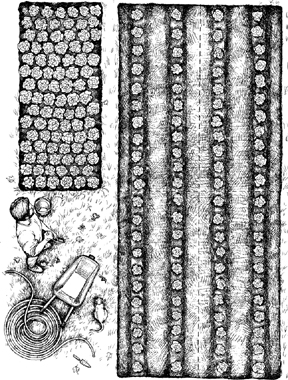
Biointensive fertility: four times the productivity in one-quarter the area!
Biointensive food raising starts with a deeply prepared garden bed whose growing area, with its closely spaced plants, can produce up to four times more than an equivalent shallow bed planted in rows. This bed means less work for the gardener, with only one bed to dig, one bed to fertilize, one bed to water, and one bed to weed. And this bed uses only one quarter the area it would take to produce the same yield by other methods. Its soil is
- loosened 2 feet deep, which results in lots of pore space for air, water, and roots;
- evenly moist because water can pass through it easily;
- full of nutrients and organic matter provided by compost;
- and planted with a variety of crops, closely spaced to provide a living mulch, reflecting natures diversity.
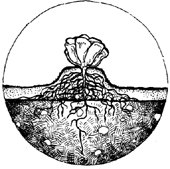
Row, end view
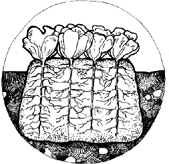
Biointensive bed, end view
Because the soil is loosened so deep, the plant roots are able to penetrate further down into the soil, instead of needing to spread out in search of water and nutrients. For that reason, plants can be spaced more closely in a Biointensive bed, allowing more plants than in a garden plot using other soil preparation methods. Also, water is more readily available to plants because more of it is retained in the deeply loosened, compost-enriched soil.
LOOKING BACK TO NATURE
A Biointensive bed is not a modern invention. Before there were farmers and gardeners, nature kept the soil covered with a profusion of plants suited to their particular environment. Plants grew best where the soil was the richest, and they did not grow in rows.


